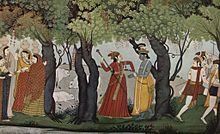
The Kadambas were an ancient royal family of Karnataka, India, that ruled northern Karnataka and the Konkan from Banavasi in present-day Uttara Kannada district. The kingdom was founded by Mayurasharma in c. 345, and at later times showed the potential of developing into imperial proportions. An indication of their imperial ambitions is provided by the titles and epithets assumed by its rulers, and the marital relations they kept with other kingdoms and empires, such as the Vakatakas and Guptas of northern India. Mayurasharma defeated the armies of the Pallavas of Kanchi possibly with the help of some native tribes and claimed sovereignty. The Kadamba power reached its peak during the rule of Kakusthavarma.
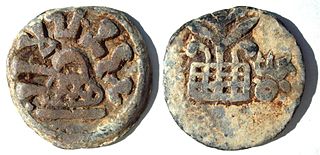
The Chutu dynasty ruled parts of the Deccan region of South India between first and third centuries CE, with its capital at Banavasi in present-day Karnataka state. The Chutus probably rose to power as Satavahanas feudatories, and assumed sovereignty after the decline of the Satavahana power. Except for the edicts of Asoka, the inscriptions of the Chutu dynasty are the oldest documents found in the northern part of Karnataka State, India.

Halasi is a town in Khanapur Taluk, Belgaum District in Karnataka, India. It is 14 km from Khanapur and about 25 km from Kittur. As known from inscriptions, the ancient name of the town was Palāśikā. A centre of the early Kadamba Dynasty, it was a minor capital of the Goa Kadambas (980-1025). The town is notable for a series of medieval temples. The most famous are the Varāha Narasiṃha temple and Suvarṇeśvara temple in the town, and a third temple of Rāmeśvara. On a hill about 1.9 km. south-west of the town is a pilgrimage place known as Rāmatītha.

North Karnataka is a geographical region in Deccan plateau from 300 to 730 metres elevation that constitutes the region of the Karnataka state in India and the region consists of 14 districts. It is drained by the Krishna River and its tributaries the Bhima, Ghataprabha, Malaprabha, and Tungabhadra. North Karnataka lies within the Deccan thorn scrub forests ecoregion, which extends north into eastern Maharashtra.
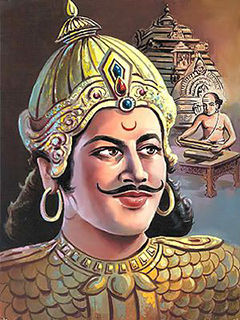
Mayurasharma or Mayuravarma, a native of Talagunda, was the founder of the Kadamba Kingdom of Banavasi, the earliest native kingdom to rule over what is today the modern state of Karnataka, India. Before the rise of the Kadambas, the centres of power ruling the land were outside the Karnataka region; thus the Kadambas' ascent to power as an independent geo-political entity, with Kannada, the language of the soil as a major regional language, is a landmark event in the history of modern Karnataka with Mayurasharma as an important historical figure. The earliest Kannada language inscriptions are attributed to the Kadambas of Banavasi.

Hodgsonia is a small genus of fruit-bearing vines in the family Cucurbitaceae.
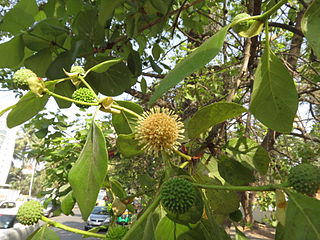
Mitragyna parvifolia is a tree species found in Asia, native to India and Sri Lanka. Mitragyna species are used medicinally and for their fine timber throughout the areas where they grow. M. parvifolia reaches heights of 50 feet with a branch spread over 15 feet. The stem is erect and branching. Flowers are yellow and grow in ball-shaped clusters. Leaves are a dark green in color, smooth, rounded in shape, and opposite in growth pattern.

Nauclea is a genus of flowering plants in the family Rubiaceae. The species are evergreen trees or shrubs that are native to the paleotropics. The terminal vegetative buds are usually strongly flattened. The generic name is derived from the Ancient Greek words naus, meaning "ship" and kleio, meaning "to close". It refers to the resemblance of the cells of the capsule to a ship's hull.
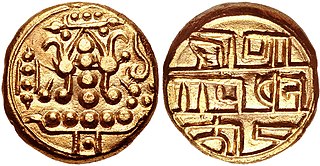
The Alupa dynasty was an ancient ruling dynasty of India. The kingdom they ruled was known as Alvakheda Arusasira and its territory spanned the coastal districts of the modern Indian state known as Karnataka. The Alupas in their prime were an independent dynasty, centuries after reigning due to the dominance of Kadambas from Banavasi, they became feudatory to them. Later they became the vassals of the Chalukyas, Rashtrakutas, Hoysalas with the change in political scenario of Southern India. Their influence over coastal Karnataka lasted for about 1200 years. There is evidence that the Alupas followed the law of matrilineal inheritance (Appekatt/Aliyasantana) since the Alupa king Soyideva was succeeded by his nephew Kulasekhara Bankideva. The legendary king who is credited with introducing matrilineality in Alva Kheda|Tulu Vishaya Kheda is named Bhuta Alupa Pandya The descendants of this dynasty still survive to this date and have spread in the karavali region and they are widely referred to as the Bunt. The Bunts follow Matrilineality instead of the common Patrilineality, and are said to be Nagavanshi Kshatriyas by their maternal origin. They can be identified with their surnames such as Shetty, Rai, Hegde, Alva, Chowta etc. Even though most Bunt are Hindus by faith now, The sizeable section of the community still follows Jainism and they are called Jain Bunt The last Alupa king to have ruled is Kulasekharadeva Alupendradeva whose inscription dated 1444 CE have been found in Mudabidri Jain Basadi.

The political history of medieval Karnataka spans the 4th to the 16th centuries in Karnataka region of India. Previously foreign empires held sway over the region, and the nucleus of power was outside modern Karnataka. The medieval era can be broadly divided into several periods: The earliest native kingdoms and imperialism; the successful domination of the Gangetic plains in northern India and rivalry with the empires of Tamilakam over the Vengi region; and the domination of the southern Deccan and consolidation against Muslim invasion. The origins of the rise of the Karnataka region as an independent power date back to the fourth-century birth of the Kadamba Dynasty of Banavasi, the earliest of the native rulers to conduct administration in the native language of Kannada in addition to the official Sanskrit. This is the historical starting point in studying the development of the region as an enduring geopolitical entity and of Kannada as an important regional language.

Melakadambur is a village located 31 kilometres (19 mi) from Chidambaram, and can reach at 6 km from Kattumannarkoil, Cuddalore district, Tamil Nadu, India. It is known for Arulmigu Amirthakateshwarar Thirukkoil temple, constructed during the reign of Cholas by Kulottunga I. The temple and the village are well known in Ponniyin Selvan history, as they are more than 1,000 years old. The Sivan temple at Melakadambur is a Paadal Petra Sthalam. This Sivalinga is self-manifested or Swayambhu Linga.

Wrightia tinctoria, Pala indigo plant or dyer's oleander, is a flowering plant species in the genus Wrightia found in India, southeast Asia and Australia. It is found in dry and moist regions in its distribution. Various parts of the plant have been used in traditional medicine, but there is no scientific evidence it is effective or safe for treating any disease.

Nauclea orientalis is a species of tree in the family Rubiaceae, native to Southeast Asia, New Guinea, and Australia. It has many common names, including bur tree, canary wood, Leichhardt pine and yellow cheesewood. It grows to a maximum of around 30 m (98 ft) in height and has large glossy leaves. It bears spherical clusters of fragrant flowers that develop into golf ball-sized edible but bitter fruits. The yellowish to orange soft wood is also used for timber and in woodcarving and folk medicine.

Naucleeae is a tribe of flowering plants in the family Rubiaceae and contains about 183 species in 24 genera. Species belonging to Naucleeae occur from Australasia, tropical Asia, Madagascar, tropical Africa, and to the Neotropics and North America.
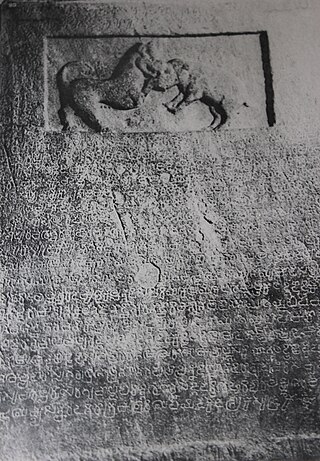
The Atakur inscription dated 949-950 C.E. is an inscribed memorial stone in classical Kannada composition. It was discovered at the Chelleshvara temple at Atakur village, about 23 km from Mandya, Karnataka, India. The "motion packed" sculptured hero stone describes two events in poetic Kannada; the battle between "Kali" the hound and a wild boar, and the victory of Rashtrakuta Emperor Krishna III over the Chola dynasty of Tanjore in the battle of Takkolam. According to historians I. K. Sarma and Singh, memorial stones for warriors are common in medieval India, but one erected in memory of an animal is considered unique.

The following outline is provided as an overview of and topical guide to Karnataka:

Bonai State was a princely state during the British Raj in what is today India. It was one of the Chota Nagpur States and had its capital at Bonaigarh, located in the present-day Sundergarh district of Odisha. It had an area of 8,907 square kilometres (3,439 sq mi) and a population of 24,026 in 1892 with an average revenue of Rs.60,000 in 1901.
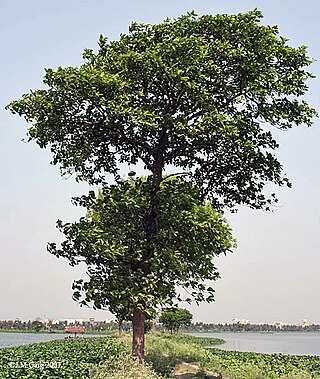
Neolamarckia is a genus with one or two species of trees native to the Old World tropics. It has often been confused with other genera, particularly Nauclea and Neonauclea to such an extent that descriptions of Neolamarckia may state incorrectly that its fruit is a capsule.

The sacred groves is a zone of Biodiversity Park, Visakhapatnam located in the premises of Rani Chandramani Devi Government Hospital. It has more than 100 sacred plant species, which are medicinal herbs with religious importance. Many sacred plants are becoming rare and endangered. Hence they are to be reared, protected, and conserved. The zone was inaugurated on February 5, 2017, by Kambhampati Hari Babu, a member of parliament from Visakhapatnam, Andhra Pradesh.
Neonauclea sessilifolia is a tree species in the Rubiaceae family. It is found in Taiwan, and then from Yunnan, Zhōngguó/China, to Southeast Asia and northeastern India.







